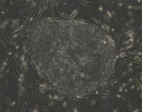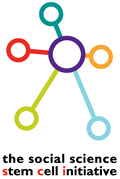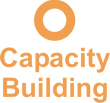BULLETIN THREE - NEW YEAR 2008

Adult or embryo derived stem cell lines? This has been a long lasting debate within the bioscience and clinical community and one that carries with is considerable bioethical baggage as well. The announcement by Jamie Thompson’s Lab in the US and Shinya Yamanaka’s in Japan that they had manage to ‘reprogramme’ somatic cells (skin cells were used) back to an embryonic state suggested we might see a ‘reprogramming’ of the field and the ethical debate itself. Thompson declared ‘The induced cells do all the things embryonic stem cells do. It's going to completely change the field. The idea of cells becoming things they don't normally become suddenly becomes viable. The new results may not eliminate the controversy [over cloned human embryos] but it may be the beginning of the end of that controversy’. Embryos could if principle no longer be needed to secure ‘embryonic’ stem cell lines through reprogramming differentiated human cells ‘back’ to a stem cell state. There is a paper on this by Park et al in the latest issue of Nature (see http://www.nature.com/nature/journal/v451/n7175/#af ).
Of course, to do this, one needs to know what the defining features of a stem cell are, and indeed those working in hESC – and seen in Park’s paper – regard the expression of a set of core genetic transcription factors, including Oct4 and Sox2, as the key markers for stem cells. This has been a focus on one of the ESRC SCI projects undertaken by Webster and Eriksson (see http://www.york.ac.uk/res/sci/projects/res340250004webster.htm)
The possibility arises therefore of creating or inducing already defined cells to revert to an earlier stage, so-called ‘ induced pluripotent stem cells’ (iPS cells). More recently, Yamanaka has called for the establishing of an iPS bank in Japan in order, he says, to reduce the time it takes to prepare cells for clinical use: growing autologous cells for a patient can take three months which is seen as being too long with some forms of disease or injury (such as spinal injury).
While the scientific community has welcomed this apparent breakthrough it has also been very public in its argument for the retention of stem cell research using cloned or embryo derived stem cell tissue, asking whether iPS cells could be – as Martin Pera from the centre of Regenerative Medicine and Stem Cells Research, California put it ‘ truly equivalent’ to hESCs?. What is notable as well is the strong argument that hESC researchers have made that iPS may not be safe. This is a point that has clouded the future application of embryonic stem cells themselves, a worry over whether once implanted they may become neo-plastic and differentiate in ways that are possibly carcinogenic. Now, a similar case is made against iPS: for example, in a piece entitled ‘The Stem Cell Wars are Not Over’, (http://www.huffingtonpost.com/susan-l-solomon/the-stem-cell-wars-are-no_b_74802.html) Solomon has claimed:
‘these reprogrammed cells cannot be used to treat human patients in the clinic, because they were created using genes and retroviruses that can cause cancer in humans. Moreover, even if other, safe ways of producing these new IPS cells are found, no one yet knows the extent to which these new cells will behave like true human embryonic stem cells.’
The claims and counterclaims about the merits of iPS over hESCs carry not only technical but also political and economic significance and this next 12 months is likely to see different scientific networks arguing the case for additional resources to be made available to both avenues of research. Clearly, regulators and commercial companies will be important as both the audience for and participants in these debates, for safety and, ultimately clinical utility, will depend on stabilising the results so that a) others can reproduce them and b) scale-up of material from research to clinical grade can happen. This issue forms the focus for the latest Research Update below.
New Policy Impact Advisory Group
The SCI has established a new Policy Impact Advisory Group who will meet for the first time later this spring and then again on three occasions prior to the completion of the Initiative. The members come from a range of academic, policy-related and science-based backgrounds. The full membership is:
Aisling Burnand - The BioIndustry Association
Jonathan Frampton - Birmingham University
Matthew Harvey - The Royal Society
James Lawford-Davies - Clifford Chance
Alison Murdoch - Newcastle University
Aurora Plomer - Sheffield University
Henry Rothstein - Kings College, London
Brian Salter - Kings College, London
![]()
Commercial Innovation and Markets
As is required, a recent press release (January 2008) from a US-based biotherapeutics stem cell company,announcing a new clinical indication for its proprietary cell lines carried the usual caveats about its own claims within the format of a ‘safe harbour statement’ that warns that the anticipated pay-off may not actually materialise. This appears in all press releases and is based on the Federal government’s Private Securities Litigation Reform Act of 1995. In it, a range of factors are identified that might create future difficulties: the firm may be unable to get regulatory approval for its products, which may not actually appear, and if they do may not work as well as expected; results in the lab might not transfer to the clinic; patents protecting the products may not be strong enough, and the methods it uses might not be accepted by the scientific community, and so on.
These are precisely some of the issues being examined by two SCI projects that have recently announced some interim results from their work in the USA and Europe, and show how social science often occupies a terrain which the very people it studies have to contend with, and need further information about.
As Harvey (http://www.york.ac.uk/res/sci/fellowships/pta350270001harvey.htm )has shown in her work, within the global context the US leads on both hESC and adult-based cell research and product development. The strength of the US stem cell economy reflects its strength in biotechnology that has contributed to a strong economic environment for translational biomedical research in the US since the mid 1970s. However, SCI work has identified two competing trends. On the one hand the stem cell industries in the US may lose their dominant position over the next few years. Problems with anti-competitive patenting, lack of regulatory agreement across the US , disagreement over funding approaches and increased competitiveness from countries outside the US are all cutting into the potential profits of the US stem cell industries. On the other hand however, regional differences in approaches to stem cell science could reverse the detrimental effects of restrictive national funding policies. Successful state-based government interventions could be enough to keep the national stem cell economy ahead in the global stem cell bioeconomy.
Martin et al (http://www.york.ac.uk/res/sci/projects/res340250007martin.htm) have also provided some important data relating to the pattern of investment in stem cells which they show has been driven by somatic cells based research and its applications. The following results are especially important:
- Adult stem cells lead the clinical development of stem cell technology
The use of haematopoietic stem cells (HSCs) is now well established in both North America and Europe . However, it remains the only stem cell to be routinely used in the clinic. In regard to clinical trials currently supported by the stem cell industry it is clear that the development of other adult stem cell therapies, especially mesenchymal stem cells, represent the main focus of activity. Only a relatively small number of human embryonic stem cell (hESC) therapies have entered clinical trials. It is worth noting that it took several decades and a great deal of incremental clinical experimentation for HSCs to become established as a routine replacement for bone marrow transplantation. Between the early 1980s and the present day over 1,000 clinical trials of HSC therapy were undertaken in the USA alone. In this context it seems likely that it will be many years before hESC based therapies are routinely used in the clinic, especially as autologous therapies present significantly fewer safety risks.
- Problems with the commercial exploitation of stem cell technology
In their detailed analysis of the emerging global stem cell industry, Martin et al show that:
- There is no single dominant business model; instead a variety of hybrid and mixed models are being adopted. This represents commercial uncertainty in the face of a lack of sales or an established market;
- Only one stem cell based therapy (Osiris’ OsteoCel) has so far reached the market and this has limited sales to date. However, a number of cell lines and reagents are being sold by firms;
- There has been very limited investment by pharma or other large companies in stem cell companies;
- There are signs of market failure for autologous cell based therapies with several companies disinvesting or withdrawing non-stem cell based therapies from this area;
In contrast there has been a rapid expansion of cord blood (stem cell) banking during the late 1990s following the rise of ‘regenerative medicine’. At the end of 2007 almost 1 million cord blood samples had been banked by commercial banks.
![]()
A number of SCI events have been planned for the first half of 2008: for example,
Innogen (Edinburgh) is holding a debate on sources of stem cells, along with some smaller workshops on adult/foetal SCR, and on ageing and SCR exploring the distinction between cosmetic and medical applications with younger and older age groups.
The SCI Office based at the University of York is planning a national workshop on automation that has generated considerable interest across clinicians, bioscientists, and equipment manufacturers and interest from a number of the research councils; it is also running a workshop on interdisciplinary research (across the social and biosciences) at the ESRC National Centre for Research Methods. It has also established a national Policy Impact Advisory Group.
Three Special Issues of the international journals New Genetics and Society and Science as Culture have been prepared and will appear in March, July and December reporting on other findings from the ESRC SCI.
Andrew Webster (SCI Coordinator) has recently published his new book, Health, Technology and Society: A Sociological Critique (Palgrave, London ) 2007. The themes of his book are illustrated throughout through reference to stem cells, genetics, and informatics.
See: http://www.palgrave.com/products/title.aspx?PID=271610
Human Fertilisation and Embryology Bill – this week in the Lords:
The reporting stage for the HFE Bill will take place in the House of Lords on 15 and 21 January. before the Third Reading and subsequent passage of the Bill to the House of Commons. You can view these proceedings 'live' through the ParliamentLive website: http://www.parliamentlive.tv/Main/ on the given dates.
![]()
The capacity building component of the SCI is supported through various initiatives at local and national levels. One is the International Visiting Fellowship scheme which allows researchers to travel abroad or visit the UK to secure a better understanding of stem cells developments across countries. The latest Fellowship is for Professor Linda Hogle from the University of Wisconsin to come to the UK in the late spring to be based at York; Linda has been working on standardisation of cell lines in the US and will be c omparing data and experiences with current UK colleagues, particularly related to the development of standards for regulatory purposes, but additionally, protocols being developed for banked and distributed cell lines.
International Petition
For those interested in arguments being put to the UN relating to the need for therapeutic cloning go to:
http://www.gopetition.com/online/14861.html
Professor Andrew Webster
Co-ordinator, ESRC Stem Cell Initiative






